Does Google Sheets Import Html Automatially Update?
Let's presume y'all've stumbled on an actionable table on some website and want to scrape this useful tabular data into your spreadsheet for analysis. You lot may try to copy and paste information technology manually, but that's a layman's way. Google Sheets has a convenient function, IMPORTHTML, to do the job. It will import the table easily and refresh your data at regular intervals to keep it updated.
But how does information technology work? In this commodity, you'll learn how to use the IMPORTHTML function to fetch tables and lists from a spider web page hands. Sound interesting? Permit's get started!
How does the IMPORTHTML office work in Google Sheets?
The Google Sheets IMPORTHTML function looks for a specific HTML tabular array or list and copies the information out of it. You tin can utilize it to scrape texts within a table or list. An HTML tabular array is defined by the <table> tag, while a list is defined by the <ul> (for unordered list) and <ol> (for ordered list) tags.
How to use IMPORTHTML formula in Google Sheets
Earlier using the IMPORTHTML formula, let's sympathize its syntax.
=IMPORTHTML(URL, query_type, index) -
URL— The URL of the page, including protocol (http://orhttps://). Make sure to enclose the URL within double-quotes. -
query_type— Use "table" if you desire to import a table, otherwise "list" if y'all're going to import a list. -
index— The alphabetize of the table or list on the web folio. It starts at 1. A table with index =onemeans that it's the first table, alphabetize =2ways that it's the 2nd tabular array, and so on.
How to get indexes of tables/lists to pull information from website to Google Sheets using IMPORTHTML
A page may contain one or more than tables and/or lists. If you take no thought how to find out the indexes of tables on an HTML page, follow the steps beneath:
Step i
Open up your browser's Programmer console. For most browsers on Windows, yous tin open the console by pressing F12. If y'all're using a Mac, employ Cmd+Opt+J for Chrome, and Cmd+Opt+C for Safari. Note that, for Safari, you'll need to enable the "Develop menu" offset.

The exact look will depend on the version of Google Chrome you're using. Information technology may change from fourth dimension to time, but should be similar.
Step 2
Copy and paste the following lawmaking into the console to get indexes of all tables:
var index = i; [].forEach.telephone call(document.getElementsByTagName("table"), office(elements) { panel.log("Index: " + alphabetize++, elements); }); If you lot are looking for all lists' indexes instead, you demand to get all elements with tag <ul> or <ol>. The post-obit code may help yous:
var alphabetize = i; [].forEach.call(document.querySelectorAll("ul,ol"), part(elements) { console.log("Index: " + index++, elements); }); Step 3
Press Enter. You volition see numbers that represent indexes shown in the results. Move your cursor over the elements in the consequence until the table/list you want to brandish is highlighted.
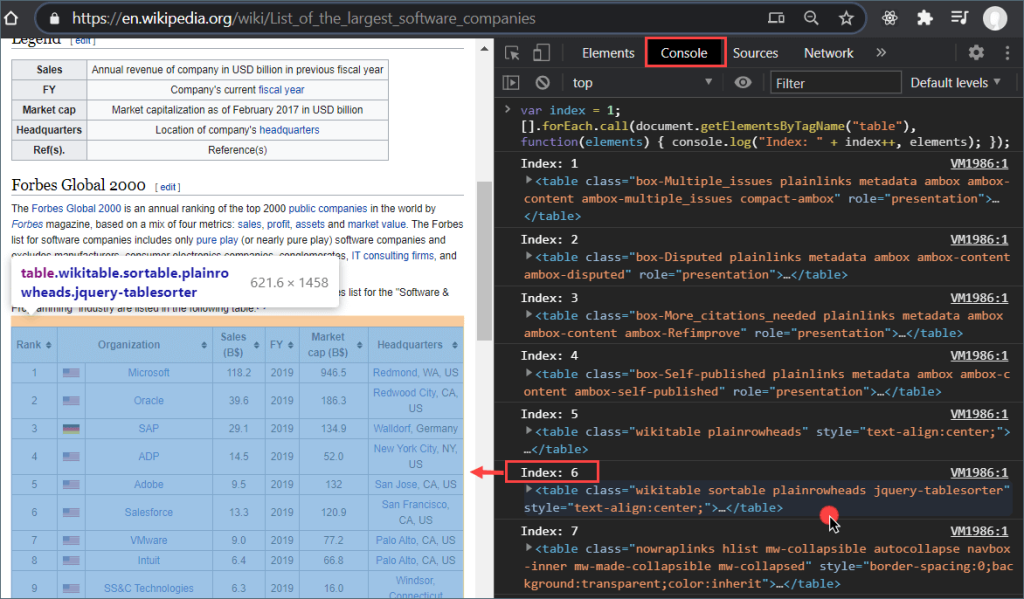
As you can see in the screenshot above, the tabular array highlighted has index = half-dozen.
How to import a table
Allow's see how we can import an HTML table. We will pull the latest currency exchange rates information from Yahoo! Finance's Currencies website to Google Sheets. The page only has one table, so nosotros'll apply one for the index value.
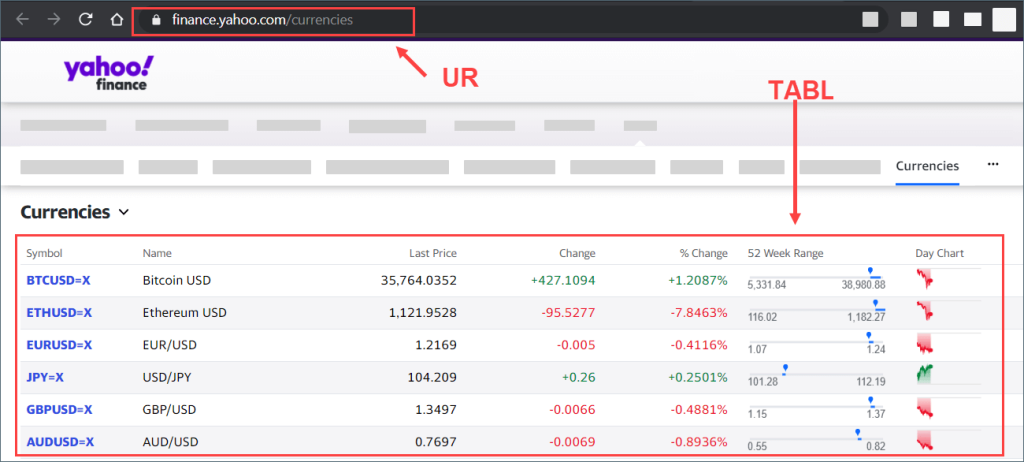
Now, create a new blank Google spreadsheet and requite it a name – for case, Currencies. Then, copy and paste the post-obit formula into A1.
=IMPORTHTML("https://finance.yahoo.com/currencies","table",one) So, press Enter and wait until the entire table is populated in the spreadsheet.
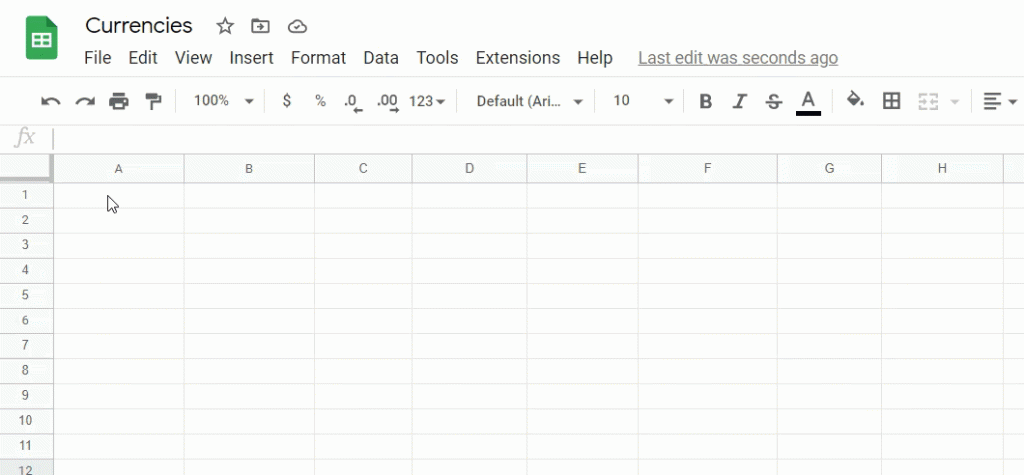
In the higher up image, we can see that the IMPORTHTML role successfully grabbed the latest currency rate data into Google Sheets.
You may be interested in monitoring the exchange rate information. In that case, you may want to bank check our tutorial on how to build a currency exchange charge per unit tracker in Google Sheets without coding.
How to import a list
You tin can import a list using the aforementioned method. The merely change would exist to supervene upon the discussion "tabular array" with "list" in the parameter. The following steps demonstrate how to pull data from a listing containing programming languages starting with the alphabetic character "C".
Create a new bare Google spreadsheet and give it a proper noun. So, copy and paste the following formula into C1:
=IMPORTHTML("https://en.wikipedia.org/wiki/List_of_programming_languages","list",7) Press Enter and expect for the data to populate, equally the post-obit screenshot shows:
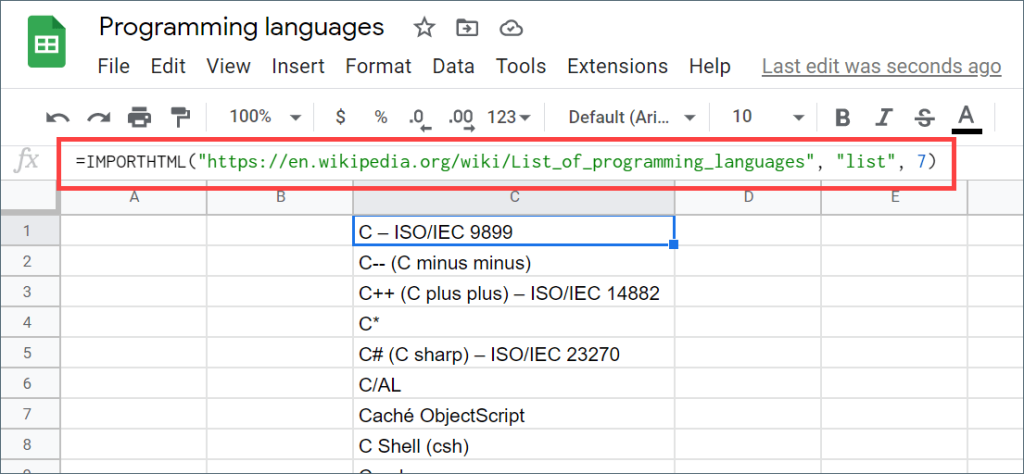
Other options for scraping data into Google Sheets
If y'all're looking for another method to retrieve data from different structure also HTML tables and lists, here are some Google Sheets functions you may want to effort:
| Part name | Description |
|---|---|
IMPORTXML | This function imports data from various structured data types including XML, HTML, CSV, TSV, as well as RSS and ATOM XML feeds. |
IMPORTRANGE | This role imports a range of cells from a specified spreadsheet. |
IMPORTFEED | This function imports an RSS or Atom feed. |
IMPORTDATA | This part imports data in CSV or TSV format from a URL. |
Many financial services share their data in JSON format through their APIs. If you lot need to scrape JSON data into Google Sheets without coding, nosotros recommend using the JSON Client importer by Coupler.io. Coupler.io is an integration solution for importing data from different sources similar Airtable, Shopify, HubSpot, WordPress, and many others.

How to reference a jail cell in IMPORTHTML in Google Sheets
Y'all may want to put the URL and other params in cells, then refer to them when using the IMPORTHTML formula. In this case, y'all tin can change the params more easily by editing the cells' values.
Here'southward an case:
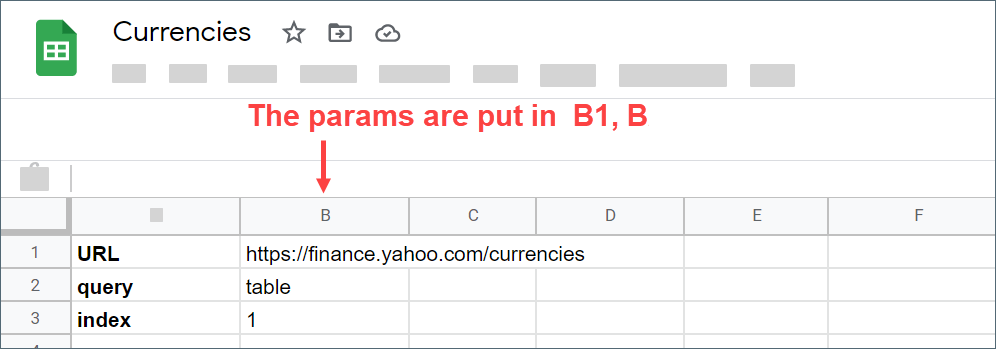
All params for URL, query, and index are put in B1, B2, and B3. Thus, you tin can easily write the IMPORTHTML formula equally follows:
=IMPORTHTML(B1,B2,B3)
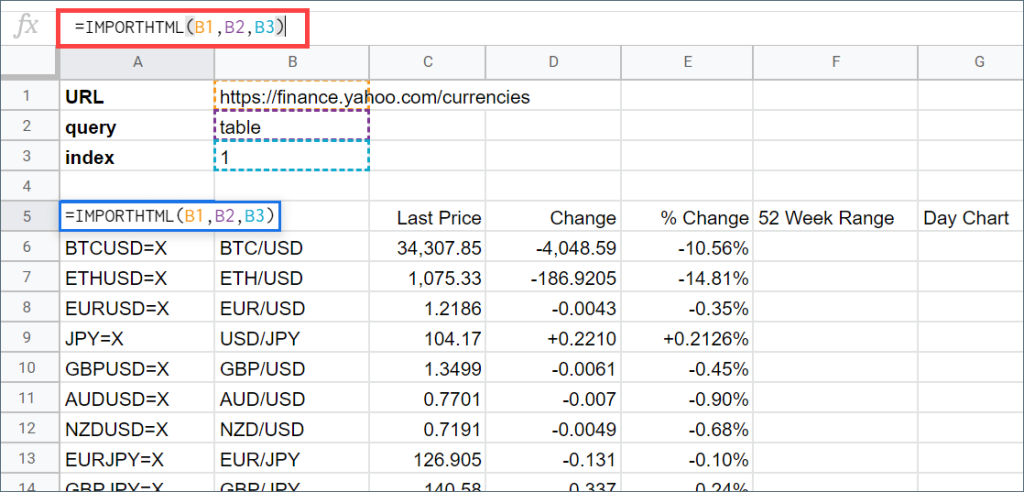
Allow's await at another example. Suppose you want to get the latest historical rates of the EUR/USD currency pair from this page:
https://finance.yahoo.com/quote/EURUSD%3DX/history?p=EURUSD%3DX You can put the string EURUSD in a cell – for case, B1. In this case, if you lot want to fetch other currency data, yous'll just need to change the value in B1. Here's an example of how to refer to the B1 cell in the Google Sheets IMPORTHTML formula:
=IMPORTHTML("https://finance.yahoo.com/quote/" & B1 & "%3DX/history?p=" & B1 & "%3DX", "table", 1) Now, let's add the above formula into A3:
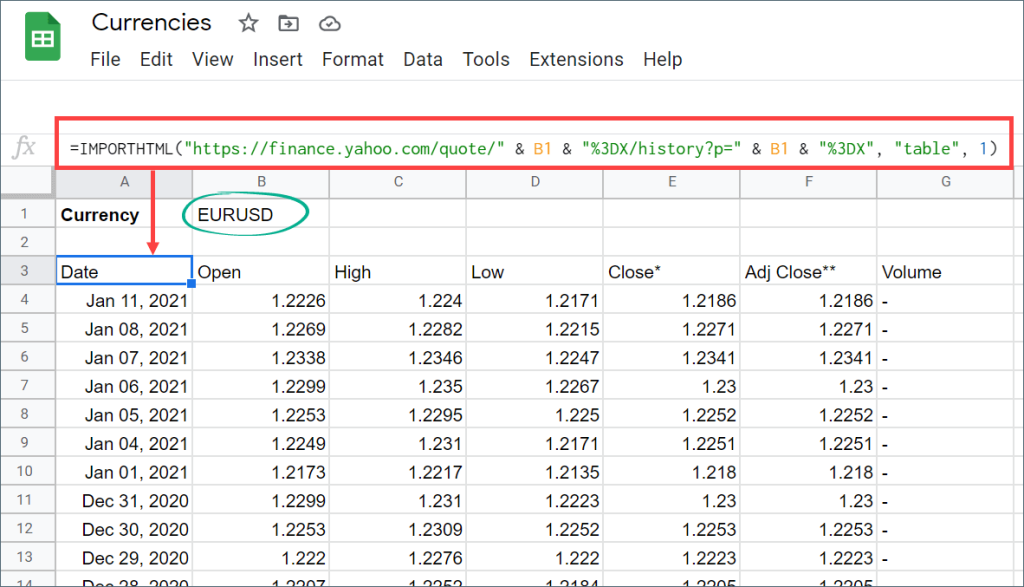
If you lot want to pull historical data for AUD/USD, alter B1's value to AUDUSD, and your data will refresh automatically.
Tip: You tin avoid typing B1 multiple times by using the SUBSTITUTE function. Here'southward what the updated formula looks like:
=IMPORTHTML(SUBSTITUTE("https://finance.yahoo.com/quote/{{CURRENCY}}%3DX/history?p={{CURRENCY}}%3DX", "{{CURRENCY}}", B1), "table", 1) How to use IMPORTHTML to import a portion of a range table data to Google Sheets
Desire to pull only a few columns? Or filter only rows with specific criteria? You can achieve these things by using the QUERY office in combination with IMPORTHTML.
Importing specific columns
Suppose y'all take a canvas with an IMPORTHTML function that pulls the latest EUR/USD rate information from a website to Google Sheets.

Now, you lot just want to call up the Engagement and Close columns that are the 1st and 5th columns. To do that, yous tin can combine your existing formula with the QUERY role — here'south an example:
=QUERY(IMPORTHTML("https://finance.yahoo.com/quote/EURUSD%3DX/history?p=EURUSD%3DX", "tabular array", 1), "SELECT Col1, Col5") By defining "SELECT Col1, Col5" in the QUERY office, you lot will get this result:

Importing specific rows
Yous can also retrieve specific rows. For example, here's how to add a filter to our previous formula to fetch merely the data with Close values higher than 1.2250:
=QUERY(IMPORTHTML("https://finance.yahoo.com/quote/EURUSD%3DX/history?p=EURUSD%3DX", "tabular array", ane), "SELECT Col1, Col5 WHERE Col5 > i.2250") 
Now, allow's add one more filter to fetch merely the peak 3 highest rates. Here's the formula:
=QUERY(IMPORTHTML("https://finance.yahoo.com/quote/EURUSD%3DX/history?p=EURUSD%3DX", "table", 1), "SELECT Col1, Col5 WHERE Col5 > 1.2250 Guild By Col5 DESC LIMIT 3") 
How to set a custom interval to automatically refresh IMPORTHTML in Google Sheets
By default, the Google Sheets IMPORTHTML refresh period is every 1 hour. However, y'all tin can speed upwards the refresh interval if you want. As the formula is recalculated when its arguments modify, you can use this to force the refresh interval. The idea is to concatenate the original URL with a query string that changes periodically based on the fourth dimension we gear up – for example, every v minutes. Here are the steps:
First, add a query cord in the original URL
Suppose we accept the post-obit values in B1-B5. The IMPORTHTML function is defined in B5. Notice that a query string "?refresh=" & B4 is added to the original URL.
| Note | Cell | Value |
| URL | B1 | https://finance.yahoo.com/currencies |
| query type | B2 | tabular array |
| alphabetize | B3 | 1 |
| refresh | B4 | one |
| formula | B5 | =IMPORTHTML(B1 & "?refresh=" & B4, B2, B3) |
The canvass looks as follows:
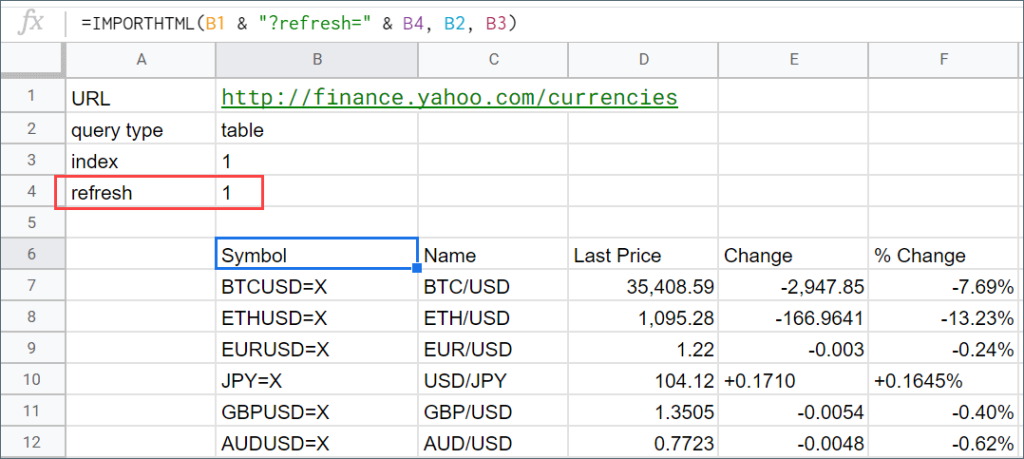
Nosotros're not done withal. Let'southward continue to the next step.
Adjacent, use script and trigger to automate refresh
Nosotros are going to refresh the value of B4 every 5 minutes using a script and trigger. Every bit a upshot, the Google Sheets IMPORTHTML formula will also refresh at the same interval. Follow these instructions:
Step 1. Go to the Script editor (either Tools > Script Editor or Extensions > App Script).

Step 2. Copy and paste the following code in the Lawmaking.gs. And then, salvage your changes by pressing the Deejay icon in the toolbar.
part myFunction() { var canvass = SpreadsheetApp.getActiveSheet(); var prison cell = canvas.getRange("B4"); var refresh = parseInt(cell.getValue().toString()); var increase = refresh + 1; cell.setValue(increment); } 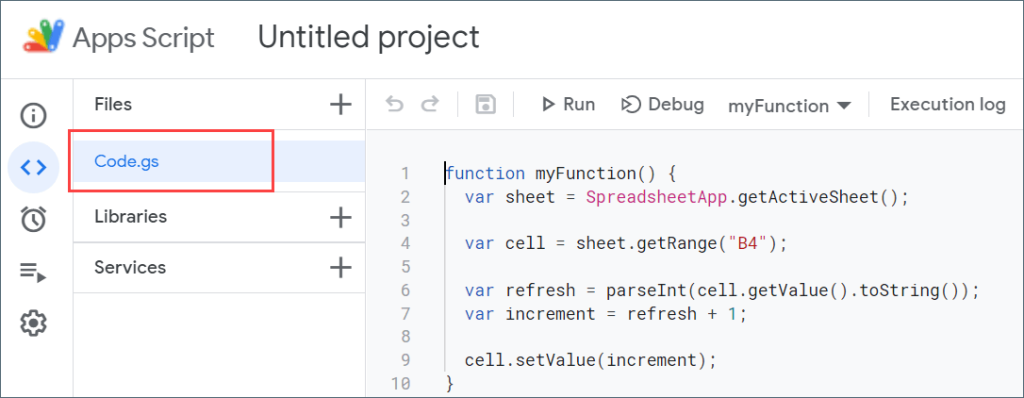
Stride 3. Open the Triggers menu on the left, then click the Add together Trigger button.
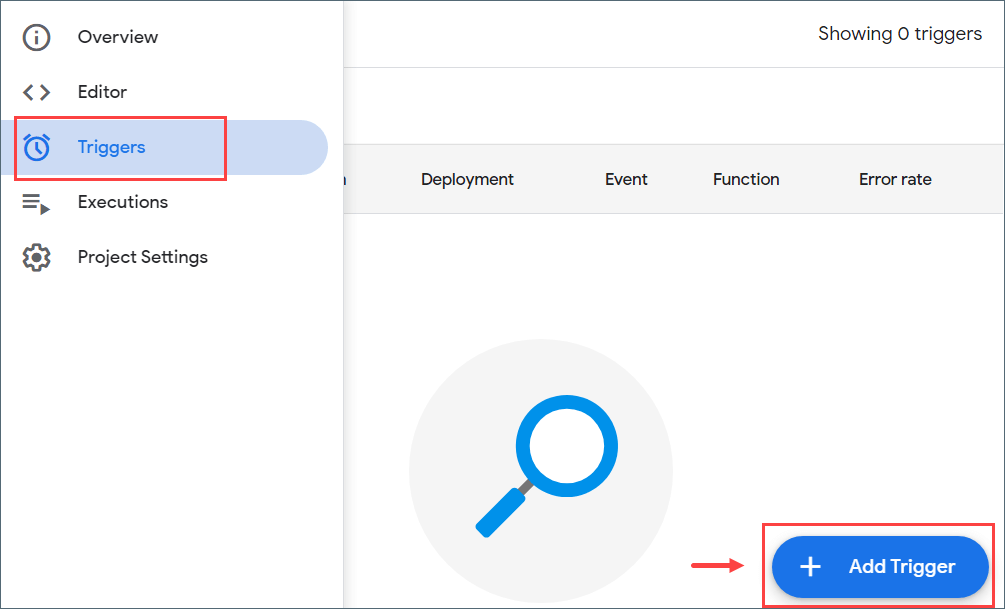
Footstep 4. Ready a trigger for myFunction so that it runs every v minutes. Optionally, you lot tin set the Failure notification settings to Notify me immediately then that you receive a notification immediately when an error occurs.
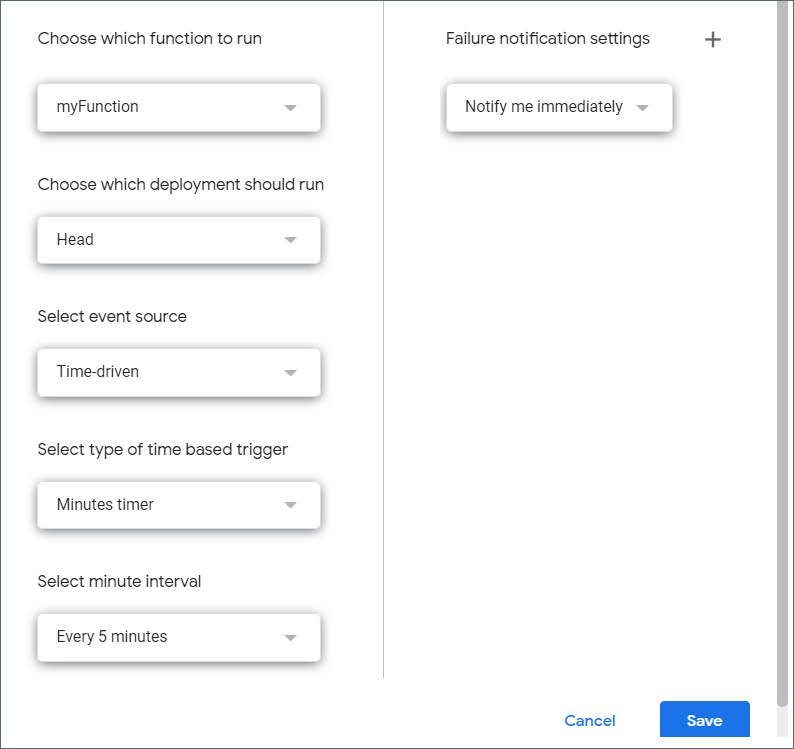
Stride 5. Click the Save button. If you lot are asked to authorize the script to access your data, grant the permission.
Step six. Run your script for the starting time fourth dimension.

At present, y'all'll be able to come across the data on your sheet refresh every v minutes. Fifty-fifty when your Google Sheet is closed, it will go on to refresh.
How many IMPORTHTMLs can Google Sheets handle?
You can use the IMPORTHTML in a Google spreadsheet as many times every bit y'all want. Before, the limit was 50 per Google spreadsheet for external data, but Google removed this limitation in 2015. Every bit Google Sheets is spider web-based, you may experience a drib in speed if you have lots of IMPORTHTML formulas in your spreadsheet peculiarly if your net connection is slow.
How to pull non-public data from a website into Google Sheets using IMPORTHTML role
Yous may desire to pull data from a non-public URL on a website into Google Sheets. Unfortunately, you lot can't practise that using the IMPORTHTML role. Encounter the following screenshot, which shows what happens if yous endeavour scraping your LinkedIn network list.

The formula just works if the page is publicly available and does not require you to log in to access the information. Y'all'll get an error message #N/A Could not fetch url for accessing non-public URLs.
What to do if IMPORTHTML formula all of a sudden not working in your Google Sheets
If your formula suddenly stops working, we recommend you to check the following things:
- Bank check for URL alter. Although it'southward a rare case, it'southward possible that the folio y'all scrape has been moved to another URL.
- Check for protocol change. For instance, the site yous're scraping is now using https instead of http, but the auto-redirect to https is not set upwardly yet by the website owner.
- Check for index change. The table or list with alphabetize = 9 could have index = 8 now.
If you still can't pull the data you want, then information technology could be that the website owner now blocks bots/crawlers from reading their web content. Cheque the website's robots.txt past navigating through <website_url>/robots.txt.
Back to Blog
Admission your data
in a simple format for free!Commencement Free
Source: https://blog.coupler.io/importhtml-function-google-sheets/
Posted by: reynoldshomply.blogspot.com


0 Response to "Does Google Sheets Import Html Automatially Update?"
Post a Comment